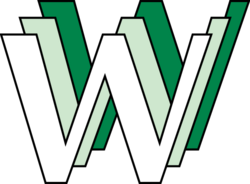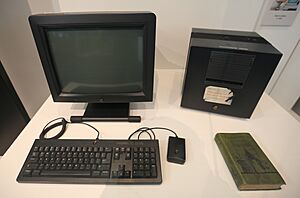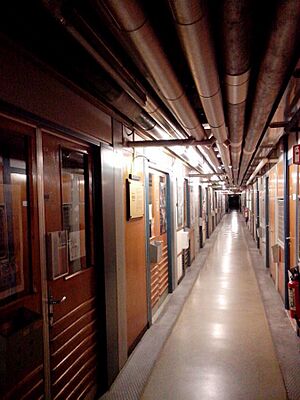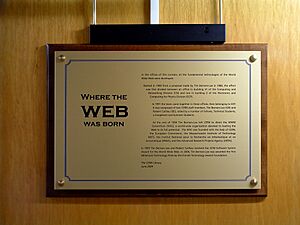History of the World Wide Web facts for kids
|
The Web's former logo designed by Robert Cailliau
|
|
| Inventor | Tim Berners-Lee |
|---|---|
| Inception | 12 March 1989 |
| Manufacturer | Lua error in Module:WikidataIB at line 168: attempt to index field 'wikibase' (a nil value). |
| Website | Lua error in Module:WikidataIB at line 168: attempt to index field 'wikibase' (a nil value). |
The World Wide Web (often called "the Web") is a huge system of information that people can access using computers connected to the Internet. Many people think the Web is the same as the Internet, but it's actually a service that runs on the Internet, just like email or online games. The Internet itself and the idea of hypertext (text with links) existed before the Web.
Tim Berners-Lee created the World Wide Web in 1989 while working at CERN, a big science lab in Switzerland. He wanted to build a "universal linked information system." He developed the first web server (a computer that stores websites), the first web browser (a program to view websites), and a special language called Hypertext Markup Language (HTML) to format web pages.
After he shared HTML in 1991 and released his browser's code in 1993, many other web browsers appeared. One very important browser was Marc Andreessen's Mosaic. It was easy to use and could show images and text on the same page. Mosaic helped make the Internet very popular in the 1990s.
Public websites started appearing around 1993–1994. This led to a "browser war" between Netscape Navigator and Internet Explorer. By 1995, all rules stopping businesses from using the Internet were removed. This led to the "dot-com boom" where many new internet companies started, followed by a "bust" in the early 2000s.
HTML changed over time, with new versions like HTML2 (1995), HTML3 and HTML4 (1997), and HTML5 (2014). New tools like Cascading Style Sheets (CSS) helped designers control how pages looked. JavaScript added programming power, making websites more interactive. Later, AJAX allowed websites to update without reloading the whole page. This started a new era called Web 2.0, where websites became more dynamic and interactive. In the 2010s, social media became very common, letting people create and share content easily. This made the Web a huge part of daily life.
Contents
How the Web Started
The idea of hypertext (text that links to other text) began in the 1960s. Researchers like Ted Nelson and Douglas Engelbart worked on systems where information could be linked together. They were inspired by Vannevar Bush's idea of a "memex" from 1945, which was like a personal library of linked information.
In 1980, Tim Berners-Lee was working at CERN in Switzerland. He built a personal database called ENQUIRE to organize information. It was also a way for him to try out hypertext, where each new page of information could be linked to another.
At first, Berners-Lee didn't know about the earlier hypertext ideas. But as he worked on his own concepts, he later found that these earlier projects confirmed his ideas were on the right track.
During the 1980s, many different computer networks grew. One important standard was the Internet protocol suite, also known as TCP/IP. As the Internet grew, people needed better ways to find and organize files. By 1985, the Domain Name System (DNS) was created, which helps computers find websites using names like "google.com."
Berners-Lee returned to CERN in 1984. He saw that physicists from all over the world needed to share data, but they used different computers and software. CERN became the largest Internet site in Europe. In 1988, the first direct Internet connection between Europe and North America was made. Berners-Lee started talking about a "web-like" system at CERN.
CERN's Big Idea
At CERN, Tim Berners-Lee was frustrated by how hard it was to find information stored on different computers. On March 12, 1989, he wrote a paper called "Information Management: A Proposal." It talked about a "web" of information based on a "large hypertext database." He imagined a system where you could click on a link in a document and instantly jump to the information it referred to. He also thought about including graphics, sound, and video.
His idea didn't get much attention at first. But his manager, Mike Sendall, encouraged him to start building the system on a new NeXT computer. Berners-Lee thought of names like Information Mesh or Mine of Information but finally chose World Wide Web. His colleague, Robert Cailliau, also became a big supporter and helped promote the idea at CERN.
Berners-Lee's big breakthrough was connecting hypertext to the Internet. He realized that if no one else was going to do it, he would. He developed three key technologies:
- URL (Uniform Resource Locator): A unique address for every piece of information on the Web, like a street address for a house.
- HTML (Hypertext Markup Language): The language used to create web pages.
- HTTP (Hypertext Transfer Protocol): The rules for how web browsers and servers talk to each other.
With Cailliau's help, he published a more formal plan on November 12, 1990. It described the "World Wide Web" (W3) as a "web" of "hypertext documents" viewed by "browsers."
By December 1990, Berners-Lee and his team had built everything needed for a working Web. This included HTTP, HTML, the first web browser (called WorldWideWeb, which could also edit pages), the first web server (called CERN httpd), and the first web site (http://info.cern.ch). This first website explained the project itself. Berners-Lee used a NeXT Computer for both the server and the browser.
Nicola Pellow, working with Berners-Lee, created the first web browser that could run on different types of computers, called the Line Mode Browser.
The Web Goes Public: Early Growth (1991–1994)
First Steps
In January 1991, the first web servers outside CERN started running. On August 6, 1991, Berners-Lee shared a summary of the World Wide Web project on an online discussion group called alt.hypertext, asking for people to help.
Paul Kunz from the Stanford Linear Accelerator Center (SLAC) visited CERN in September 1991. He was very impressed by the Web. He brought the NeXT software back to SLAC, where it was used to host a database of documents. This became the first web server outside Europe and the first in North America.
The World Wide Web was different from other systems at the time. It used "unidirectional links," meaning you could link to someone else's page without them having to do anything. This made it much easier to create web pages and browsers.
Early Web Browsers
The first browser, WorldWideWeb, only worked on the NeXTSTEP operating system. This was a problem. In April 1992, Erwise was released, developed at the Helsinki University of Technology. In May, ViolaWWW was created by Pei-Yuan Wei. ViolaWWW had advanced features like embedded graphics and animation. Both worked on Unix computers. ViolaWWW became the recommended browser at CERN. To encourage its use, CERN put its phone directory on the Web.
Students at the University of Kansas adapted a text-only browser called Lynx to access the Web in 1992. Lynx worked on Unix and DOS computers. Some web designers even believed that if a website couldn't be seen with Lynx, it wasn't a good website.
In these early browsers, images would open in a separate program, not directly on the web page.
From Gopher to the Web
In the early 1990s, other Internet systems like Gopher tried to organize data. Gopher was a system for browsing documents, released in 1991. It became the first widely used system for linking information on the Internet. Many people thought Gopher would be the main way people used the Internet.
However, in 1993, the University of Minnesota, which created Gopher, said that businesses would have to pay to use it.
In response, on April 30, 1993, CERN announced that the World Wide Web would be completely free for everyone, with no fees. They released their code to the public. This decision was a huge turning point. It allowed anyone to develop web servers and browsers without paying for licenses. This led to a rapid shift away from Gopher and helped the Web grow very quickly.
Early websites often had links to both HTTP (Web) and Gopher content. Users would find pages by bookmarking popular directories or looking at "What's New" lists.
After 1993, the Web saw many improvements in how information was found, especially with the rise of search engines. As the Web became easier to use, businesses started investing in it. By mid-1994, the Web was much more popular than Gopher and other browsing systems.
NCSA and Mosaic
The National Center for Supercomputing Applications (NCSA) at the University of Illinois launched a website in November 1992. After seeing ViolaWWW, a student named Marc Andreessen started working on Mosaic with Eric Bina. They released a Unix version in February 1993, followed by Mac and Windows versions in August 1993.
Mosaic became very popular because it could show images directly on web pages, something earlier browsers couldn't do easily. It also allowed users to fill out online forms. Historians generally agree that Mosaic's release in 1993 was a major turning point for the World Wide Web.
Before Mosaic, graphics were not usually mixed with text on web pages. The Web was less popular than older systems like Gopher. Mosaic changed this by displaying images and text together. NCSA also created a web server called HTTPd. Both Mosaic and HTTPd were free to use. Mosaic was an instant success. Its easy-to-use graphical interface made the Web the most popular way to use the Internet. Within a year, Web traffic was higher than Gopher's.
Early Growth of the Web
The World Wide Web made it easy to share information over the Internet in a flexible way. This helped make the Internet popular. While people sometimes use "World Wide Web" and "Internet" to mean the same thing, they are different. The Web is a space of linked documents and resources, while the Internet is the network of computers that connects them.
At first, the Web was mostly used by university science departments and physics labs like SLAC. By January 1993, there were 50 web servers around the world. By October 1993, there were over 500.
Sharing media like videos and music on the Web became possible because of better ways to compress data. Formats like MPEG (for video) in 1991 and JPEG (for images) in 1992 helped. JPEG became the most used image format on the Web because it made images small enough for slower Internet connections. MP3, an audio format, also became very popular on the Web.
In 1992, CERN decided to stop supporting Berners-Lee's work, saying it wasn't their main focus. After this, Tim Berners-Lee left CERN and went to the Massachusetts Institute of Technology (MIT) to continue developing HTTP.
The first web browser for Microsoft Windows was Cello, released in June 1993. It was created for lawyers to access legal information, as Windows was widely used by them.
Open Standards and Going Global (1994–2004)
The number of websites grew rapidly around the world. This led to the need for international rules (standards) for how web pages and protocols should work. Berners-Lee continued to help guide these standards.
World Wide Web Conference
In May 1994, the first International WWW Conference was held at CERN. This conference has been held every year since.
World Wide Web Consortium (W3C)
The World Wide Web Consortium (W3C) was started by Tim Berners-Lee in 1994. He left CERN to create open standards for the Web. The W3C was founded at MIT with support from DARPA, which helped create the Internet. Later, other sites were opened in France and Japan.
The W3C brought together companies to create standards and recommendations to improve the Web. Berners-Lee wanted the Web to be free for everyone, with no patents or fees. The W3C decided that its standards must be based on technology that is free to use.
At first, companies like Netscape and Microsoft, who were in a "browser war," didn't always follow the W3C's rules. They added their own features to HTML. But by 1995, they agreed to follow the W3C's standards.
The W3C released the standard for HTML 4 in 1997, which included Cascading Style Sheets (CSS). CSS gave designers much more control over how web pages looked. Even so, browsers didn't always follow all the rules perfectly. This led to the creation of the Web Standards Project (WaSP) in 1998, which pushed for browsers to follow the standards.
Businesses, Boom, and Bust
As the Web grew in the mid-1990s, web directories (like phone books for websites) and early search engines were created to help people find information. In 1995, rules that limited businesses from using the Internet were removed.
In the US, America Online (AOL) offered its users Internet access through its own browser. In January 1994, Yahoo! was founded by Jerry Yang and David Filo. The Yahoo! Directory became the first popular web directory, and Yahoo! Search was the first popular search engine.
Online shopping began with Amazon (founded by Jeff Bezos) and eBay (founded by Pierre Omidyar) in 1995.
By 1994, Marc Andreessen's Netscape Navigator became the most popular browser. In 1995, Bill Gates outlined Microsoft's plan to become a leader on the Internet. With the release of Windows 95 and the Internet Explorer browser, many companies started creating websites. People were excited about free publishing and instant worldwide information. By the late 1990s, search engines like Google Search became more important than directories.
Netscape had a very successful stock market launch, even without making much profit. This helped start the "dot-com bubble" where many new internet companies were created, often with just a website. Over the next five years, huge amounts of money were invested in these startups.
During the dot-com boom, many companies tried to create a main "web portal" (a website that was a starting point for everything). They wanted to attract a large audience for online advertising. But Google was different. It was a simple search engine that gave much better results. Users loved Google and switched from portals. Google also had a very successful business model with AdWords.
AOL bought Netscape in 1998, but Netscape couldn't compete with Microsoft. Internet Explorer became the dominant browser for many years.
Faster broadband internet connections started replacing slower dial-up connections in the early 2000s.
When the dot-com bubble burst, many web portals and internet companies either closed down or greatly reduced their operations. AOL stopped developing Netscape in 2003.
Web Server Software
Web server software was created to allow computers to act as web servers. At first, these servers only handled static files like HTML pages and images. Now, they can run complex applications. Content management systems (CMS) were developed to help people create and organize website content together.
After Robert McCool left NCSA, development on the NCSA HTTPd server slowed down. In 1995, Brian Behlendorf and Cliff Skolnick started a mailing list to fix bugs and improve HTTPd. They called their version Apache. Apache quickly became the most popular web server. It allowed developers to use different programming languages like Perl, PHP, and Python. Along with Linux and MySQL, it became known as the LAMP platform.
The Apache Software Foundation was founded in 1999 and created many open source web software projects.
Browser Wars
After college, Andreessen and James H. Clark formed Mosaic Communications Corporation in April 1994 to create a commercial browser. They later changed the company name to Netscape, and the browser became Netscape Navigator. It quickly became the most popular web browser. They also released the Netsite Commerce web server, which could handle SSL requests, making e-commerce secure. SSL became the standard way to encrypt web traffic. Navigator 1.0 also introduced cookies. In 1998, Netscape made Navigator open source and launched Mozilla.
Microsoft licensed Mosaic from Spyglass and released Internet Explorer 1.0 in 1995, and IE2 later that year. IE2 added features like cookies, SSL, and JavaScript. The "browser wars" became a big competition when Microsoft started including Internet Explorer with Windows. This led to a famous antitrust lawsuit against Microsoft.
IE3, released in 1996, added support for Java and CSS. Microsoft began bundling IE with Windows. IE3 helped Microsoft's browser market share grow significantly. IE4, released the next year, introduced Dynamic HTML, which set the stage for the Web 2.0 revolution. By 1998, IE had most of the desktop browser market and remained dominant for 14 years.
Google released its Chrome browser in 2008. Chrome quickly became the dominant desktop browser in four years. Google also made Chrome's code open source as Chromium.
Ryan Dahl used Chromium's V8 engine in 2009 to create Node.js, which allowed JavaScript code to run on servers. This led to new software systems.
Acer and Samsung started selling Chromebooks in 2011. These are affordable laptops that run ChromeOS and are designed for web apps. Chromebooks became very popular, even outselling MacOS devices in 2020.
Other important web browsers include Mozilla's Firefox, Opera, and Apple's Safari.
The Web as a Platform: Ubiquity (2004–Present)
Web 2.0
Web pages were first simple documents based on HTML, mostly static. By the mid-2000s, new ways of sharing content like blogs and RSS became popular. The video-sharing website YouTube introduced the idea of user-generated content, where anyone could upload videos. As new technologies made it easier to create dynamic websites, the Web became more interactive and popular. This new era also brought social networking websites like Friendster, MySpace, Facebook, and Twitter, and photo/video sites like Flickr and Instagram. These sites quickly gained users and became a central part of youth culture. Wikipedia, with its user-edited content, quickly became more popular than traditional encyclopedias. This new, media-rich way of sharing information, with user-created and user-edited content, was called Web 2.0.
JavaScript made interactive web applications possible. Web pages could run JavaScript and react to what users did. However, they couldn't easily talk to the network without reloading the whole page. This was slow compared to desktop programs.
In 1999, Microsoft added a feature called XMLHttpRequest to Internet Explorer. This allowed a web page to talk to the server without reloading. In 2002, developers at Oddpost used this feature to create the first Ajax application, a webmail client that worked as smoothly as a desktop program. Ajax apps were revolutionary. Web pages changed from static documents to full applications. Websites started offering APIs (ways for other programs to get data from them). Analysts called this Web 2.0.
Browser makers improved their JavaScript engines and stopped supporting older technologies like Flash and Java. Traditional desktop applications were replaced by cloud apps. Amazon became a huge cloud service provider.
The use of social media on the Web is now a part of everyday life. The 2010s also saw the rise of streaming services like Netflix.
Security and Cybercrime
The increasing use of encrypted connections (HTTPS) made e-commerce and online banking safe. However, the 2010s also saw the rise of internet censorship and cybercrime, including web-based cyberattacks and ransomware.
Mobile Web
Early attempts to get wireless devices to access the Web used simpler formats like WAP. Apple introduced the first smartphone in 2007 with a full web browser. Other companies followed, and by 2011, smartphone sales were higher than PC sales. Since 2016, most people access websites using mobile devices. This led to the development of responsive web design, where websites adjust to fit different screen sizes.
Google announced specifications for Accelerated Mobile Pages (AMP) and progressive web applications (PWA) in 2015. AMPs optimize web pages for mobile devices. PWAs are web pages that can be saved to a mobile device and opened like a regular app.
Web 3.0 and Web3
The idea of extending the Web to make data exchange easier led to the concept of the Semantic Web (sometimes called Web 3.0). This involves using information that machines can understand, allowing programs to intelligently find information for users. The Web has also focused on connecting devices to the Internet, known as Intelligent Device Management.
This has led to the Internet of Things (IoT), where modern devices are connected through sensors and software, exchanging information with other devices and systems on the Internet. This allows data to be collected and analyzed instantly, improving decision-making. Also, combining AI with IoT devices makes them even smarter, helping them predict user needs and perform tasks.
Web3 (sometimes also called Web 3.0) is a newer idea for a decentralized web based on blockchains, smart contracts, and digital tokens.
Images for kids
See also
 In Spanish: Historia de la World Wide Web para niños
In Spanish: Historia de la World Wide Web para niños
- History of email
- History of hypertext
- History of the Internet
- History of telecommunication
- List of websites founded before 1995
Online services before the World Wide Web
- Minitel
- NABU Network
- Quantum Link






